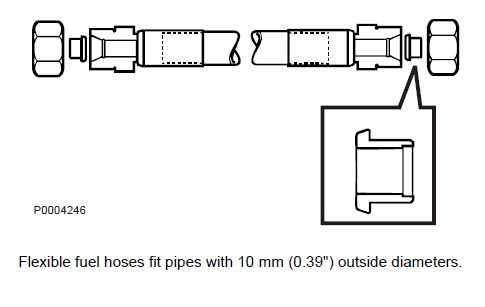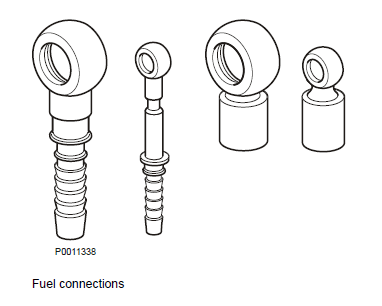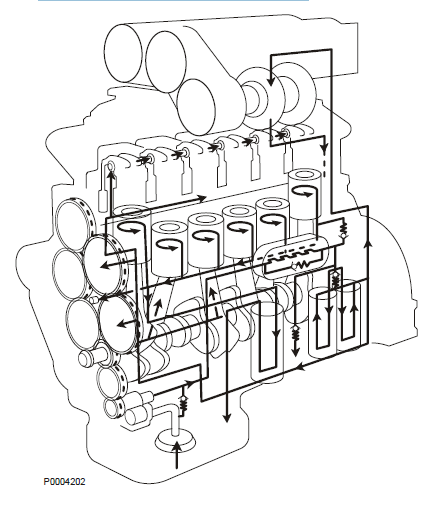Piping
Fuel Line Installation
Fuel lines that are connected to the engine may not be of metal or have metal reinforcements. Metal can cause fuel leakages as static electricity may creep through the it and cause holes in the fuel line. The fuel lines must be run so that fuel is not heated by engine heat radiation. Refer to the technical data for the engine concerned for maximum fuel temperatures. The lines must be run as straight as possible without sharp bends. Make sure the lines are protected from mechanical wear and that they are securely fastened to avoid vibration damage. It is important that there are no leaks on either the suction or return line installations. Use approved materials in the fuel lines that tolerate biodiesel (FAME) such as:

Rubber
- Fluoro rubber FPM
Plastic
- Polyamide 6, PA6
- Polyamide 11, PA11
- Polyoxymethylene, POM
- Polyethylene MDPE or HDPE
Other approved materials are Teflon, Nylon and Viton (FPM). We recommend the use of flexible fuel hoses between the engine and fuel pipes. These must always be used if the engine is installed on flexible engine mounts. The fuel lines must have a sufficient inner diameter in relation to the pipe length so as not to exceed maximum permissible pressure drop. Refer to the technical date for the engine concerned in the Sales Support Tool, Partner Network. The fuel return line must be run to the upper part of the fuel tank and may not be connected to the suction line. The return line must always discharge below tank minimum fuel level.

D9, D11, D13 and D16 engines are delivered with hose connections in the following standard dimensions:
- Suction hose from tank; 3/8'' or 9.5 mm
- Return hose to tank; 1/4'' or 6.35 mm
Nipples for male connections with the following imperial threads are supplied as options:
- Supply: NPSF 3/8''
- Return: NPSF 1/4''
Volvo Penta can provide information regarding approved fuel hoses available for connection between the engine and fuel pipes or between the engine and tank.
Lubrication System
General
Engine oil is a common name for lubricating oils intended for use in internal combustion engines. No intrusions or changes may be made to the engine lubricating oil system other than with Volvo Penta approved accessories. Engine oil comprises base oils and various additives. It must meet the following requirements:
Good lubrication qualities
The main function of engine oil is to reduce friction and wear by creating a durable, protective film between the moving parts of an engine. High temperatures in cylinders and bearings place especially high demands on the oil film.
Good resistance to oxidation
This is necessary for reliable function, as oxidation easily occurs at high temperatures and causes damage e.g. through resin layers on vital engine parts.
Good detergent qualities
Harmful coatings are avoided, as soot and other combustion deposits are held in suspension by a dispersing agent added to the oil. Detergents also help to keep engine parts clean.
Corrosion protection
Engine oil must protect cylinder liner surfaces, bearings and other components against corrosion that would otherwise easily occur because of the moisture and acids formed during fuel combustion.
Anti-foaming characteristics
Oil that splashes around in the crank case forms a foam of air bubbles that can prevent lubrication if they are allowed to reach lubrication points. Anti-foaming agents make sure that the bubbles burst when they reach the surface in the oil bath.
Low temperature characteristics
The oil must have characteristics suitable for low temperatures in order to prevent cold start wear and to ensure that the engine starts without problem at low temperatures.

Heat conductivity
The oil must be able to carry heat away from hot engine components.
Sealing characteristics
An engine requires high compression to provide maximum power. One of the functions of engine oil is to form a sealing film between the pistons and the cylinder walls.
Suitability for all operational conditions
Engine oil requirements vary depending on the type of engine and its operational conditions.
Engine Oil Specifications
The right lubricating oil
It is important both technically and economically to choose the right lubricating oil for each individual application. The requirements for the right lubricating oil type depend not only on the part of the vehicle in which it is to be used, but also on vehicle design and operational conditions. Presented below are VDS standards based on the requirements placed on lubricating oil quality.
Volvo Drain Specification (VDS)
VDS quality has requirements for certain oil specifications based on Volvo truck field tests. The first VDS category was introduced in 1982 and has been successively adapted to the latest engine designs ever since. VDS-2 was introduced in 1992, revised in 1995 and followed by VDS-3 in the year 2000, revised in 2002. The chief test parameters are piston deposits and cylinder bore polishing, but other parameters such as piston ring and bearing wear, engine cleanliness and oil decomposition are also analyzed. VDS field tests were carried out on F12 trucks (TD121 and TD122 engines) at 50,000 km change intervals. The lowest comparable oil grade is API CD. VDS II field tests were carried out on FH12 trucks (D12A engines) at 60,000 km change intervals. The lowest comparable oil grades are ACEA E3 or API CG-4.
VDS III SAE 10W-40 was developed in 2002 to take care of an increasing soot content and acidity formed with EGR (a certain exhaust return to combustion). Quality grade are API CI-4/CH-4 or ACEA E7 VDS IV SAE 10W-30, SAE 15W-40. Quality grade are or API CJ-4/ACEA E9
Extra additives
The additives oil companies select are the result of prolonged tests. The additives are mixed with the oil under accurate control. Therefore Volvo points out clearly and forcefully that no extra additives or so-called engine or metal treatments sold for engine oils may be added to any lubricating oil used in Volvo products. The addition of such additives does not improve lubricant quality and can in certain circumstances cause more harm than good.
Brands
In common with other vehicle manufacturers, Volvo has established lubricating oil quality requirements for its products. Therefore Volvo Penta only recommends the use of well-known brands of oil. We would like to point out that it is the responsibility of oil manufacturers to ensure that their different products meet the standards concerned. Volvo disclaims all responsibility concerning this and likewise such consequences as may arise as a result of any changes in product designations. Which oil quality your engine needs are further described in the Sales Support Tool, Partner Network.
For More Volvo Engine workshop information, please visit
Volvo Penta Engine Fuel System
Copyright © Guangxi Dingbo Generator Set Manufacturing Co., Ltd. All Rights Reserved | Sitemap
Update cookies preferences